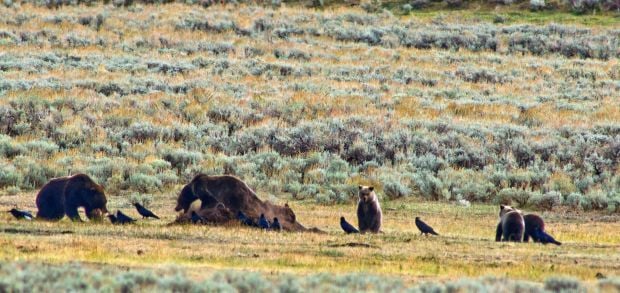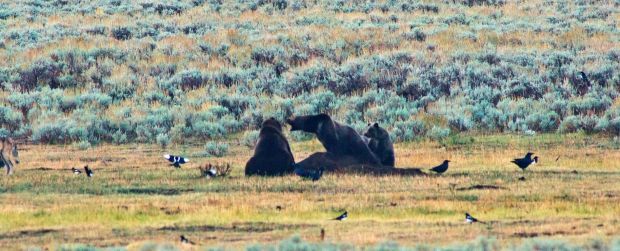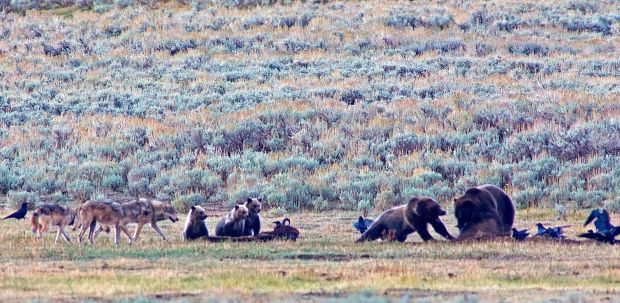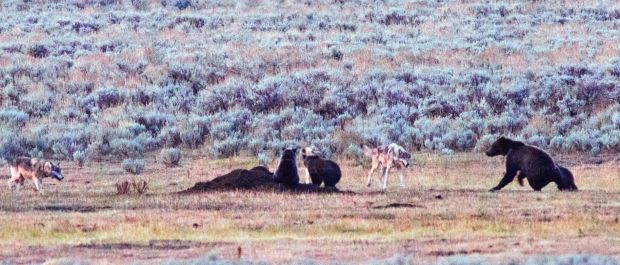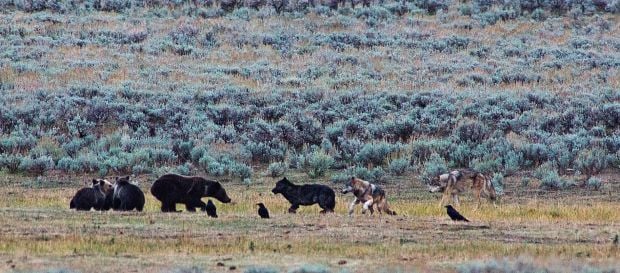
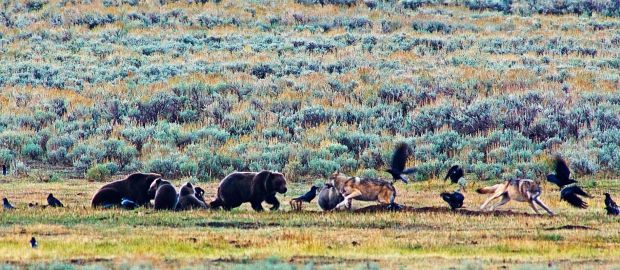
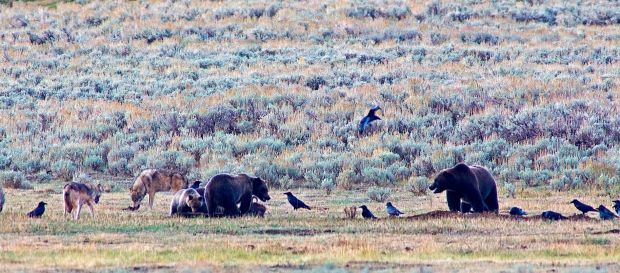

Across the Lamar River near its intersection with Soda Butte Creek, a bison had died on the sagebrush-dotted prairie. Claiming the carcass was a large male grizzly bear — called a boar. As the boar ate, five wolves from the Junction Butte wolf pack circled, waiting for an opportunity to dash in for a stray morsel of flesh to satisfy their own hunger. On the edges, crows, ravens and magpies stood and flitted, awaiting their chance to clean up.
This scene in itself was impressive, but what really made the show extraordinary was when a sow grizzly and her three cubs ambled in. It was a predator-scavenger menagerie. “The behavior was phenomenal for three days,” Bengeyfield said. “I’ve never seen anything that interesting within camera range.”
Captured on camera
Bengeyfield’s series of photos show a variety of interesting interactions among the animals: four wolves laying around the carcass as the boar stands atop the bison as if to say, “Hey, this is my bison, you better stay back;” the sow and her cubs approaching and getting an ears-back glare from the boar and two wolves in a not-so-veiled threat that they didn’t want any more competition for the food; the sow standing atop the carcass in a cloud of dust, both bears with their mouths agape, as she claims the carcass while her cubs wait to the side; the sow, mouth opened as if roaring into the boar’s ear as his back is to the camera and she stands atop the carcass; the sow appearing ready to bite the big boar in the face as he pulls his head out of the way and growls back; the sow moving off the carcass to shoo off a snarling wolf; three wolves surrounding the three cubs, who are tightly grouped together; the sow coming to the rescue as a black wolf flees while looking back over its shoulder; the sow standing nose-to-nose with the black wolf, the cubs behind her and the black wolf backed up by two gray wolves — a Yellowstone standoff; the sow standing upright on its hind legs as it looks toward the photographer amid a gathering of crows, magpies, the cubs and one wolf.
The interaction played out over three days, Sept. 15-17, weeks before a government shutdown closed the park to the public. Bengeyfield had heard about the photo opportunity from his friend, Bob Landis, a renowned videographer who roams the national park.
Bengeyfield estimated the human crowd gathered to watch the animals numbered about 125. To see the best show, they had to arrive early. That’s because most of the action occurred at first light when the sow and cubs sauntered down to the kill site.
Unfortunately, at that time of day the light for shooting photographs was dim. Bengeyfield was using his 600mm lens topped with a 1.4 converter to get closer to the action, effectively boosting the lens to 1,260mm. “But even then the image had to be cropped,” he said.
Feeding frenzy
Fall is when bears enter a phase called hyperphagia, when they are trying to consume as many calories as possible to build up fat before entering hibernation. That can make them extremely defensive of food sources.
Boars are also known to kill grizzly cubs so that the sows will go into estrus and can be bred by the
boar. So to see four bears on one carcass prompted speculation that maybe the cubs were the boar’s offspring, Bengeyfield said.
Such communal feeding by grizzly bears on a carcass does occur occasionally, said Kerry Gunther, Yellowstone’s bear management biologist, although it’s not common. More often, a boar will displace a sow to claim the carcass. To ensure no other animal eats the carcass, the bear will often sleep on top of its dead prey.
The other theory is that, after feeding for a couple of days, the boar simply couldn’t eat anymore, so he wasn’t as possessive of the carcass when it came to the sow and cubs. That wasn’t the case with the sow, her cubs and the wolves, though, Bengeyfield said. At times, the wolves would try and isolate one of the cubs, angering the sow who would charge out to protect her offspring. “They never tolerated the wolves who tried to get the cubs,” he said.
Sticking with it
Bengeyfield is a retired Forest Service hydrologist who lives in Dillon. He often travels from his home to the park to shoot photos. He’s also given photo tours and taught classes in the park.
Often, his field trips are unproductive and he comes away with few good wildlife shots. “There have been a lot of times there’s been nothing, so I was due,” Bengeyfield said.
So to have such an interesting interaction within camera range was exhilarating and fulfilling. “When that occurs, you stay with it till it’s done,” Bengeyfield said. “That doesn’t happen that often that close to the road.”
source

